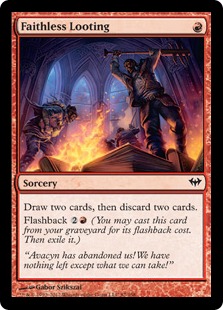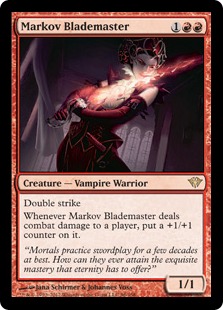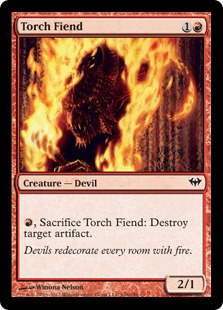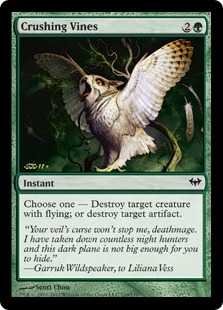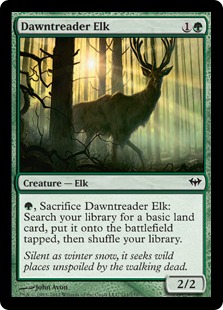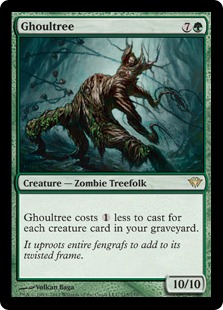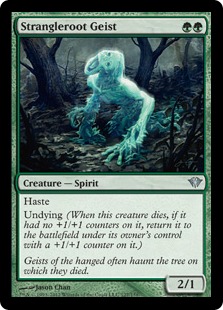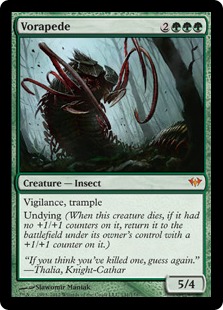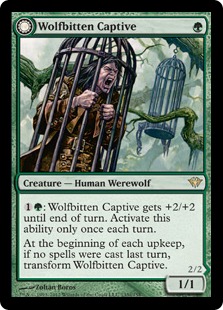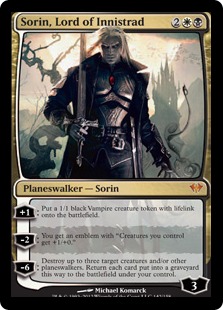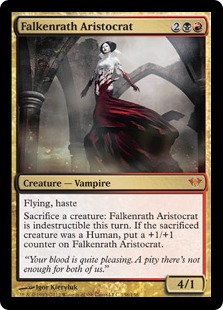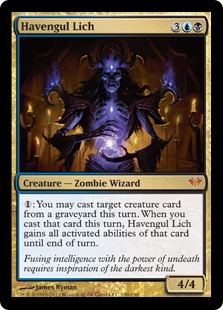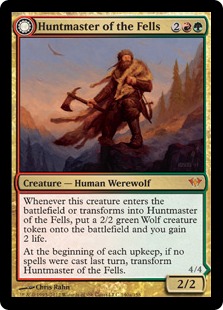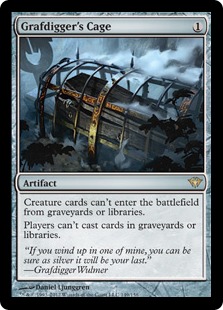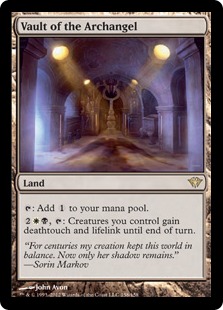Usman: Welcome back for Part 2 of our Cube Chronicle Quarterly: Dark Ascension review. We gave cubers a lot to talk about in Part 1, and Part 2 looks to give us more interesting tools for our cubes. We’ll jump right back into the cube cards with red’s Faithless Looting.
Parnell: Speaking of interesting tools, we have a unique effect for red in this flashbacking Careful Study. We have the long known about Faithless Looting, but it’s making its first appearance without sporting the awful Dack Fayden art. Usman, I know you’ve tested this in your cube already, after it was spoiled on the Mothership via the comic promo. What’s the early outlook?
Usman: Faithless Looting reminds me somewhat of Reckless Charge, not just because they share the same casting cost and flashback cost, but because they’re cards that seem unimpressive. They don’t appear to fit what red aggressive decks want; non-creature spells in red-based aggro decks tend to be either burn or equipment, and both cards don’t really fall into either category. However, both cards help to provide consistency and smooth decks out. People who don’t like aggressive decks in cube complain that “your Jackal Pups suck on turn 7 when your opponent has dragons” (which you shouldn’t be letting your opponent cast in the aggro v. control matchup), and Faithless Looting helps in that regard. It helps ditch cards whose value has dropped in the middle to later stages of the game. That and helping to dig for answers/direct damage when the opponent is at low stages of life.
Parnell: In all fairness, Jackal Pup sucks turn two forward, but that isn’t his fault. When I first saw this card over a month ago, I dismissed it as something a person drafting red would be interested in. It was Careful Study in a worse color for it, and the flashback provided minimal value. What I didn’t realize is this is more similar to “draw two” for R than anything, and with flashback to help push along your draws, this card really is unprecedented in red.
I still don’t know what to cut for it in my cube, and I’m guessing that once doubters like myself fully understand its role, making the swap for another card (that won’t be anything like it) is going to be the most difficult part. The fact that this card is amazing in any sort of red-producing control deck is just icing on the cake. My recommendation would be to find the red card in your cube that you’re least happy with and make the swap to try it out.
Usman: There isn’t a shortage of cubeworthy four-mana red creatures, and cube designers haven’t exactly been clamoring for another, especially since we got Moltensteel Dragon (who’s actually a four-drop). Regardless, Hellrider should make waves in cubes as a solid curve topper in red aggro decks. Remember when Lava Hounds was considered to be good in cube? How far we’ve come, especially as this guy is at worst a virtual 4/3 for 2RR!
Parnell: Dude, I cannot express how much I love this guy. It’s like every red mage had a meeting to build a sweet four-drop, and once he was suggested, everyone just nodded in agreement. Instead of going on and on about how sweet Hellrider is, I’m just going to tell you to fit him in your cube. I don’t care what you cut (Whoa, WHOA, not Sulfuric Vortex. Yes, Chandra, the Firebrand is fine to cut…); just GET HIM IN. The “downside” we’re looking at is a slightly worse Keldon Champion with no echo; the upside is you curve into him on turn four with three other creatures in play. He’s basically Hero of Oxid Ridge the sequel, and I don’t think anyone has much bad to say about him.
Usman: It’s also a really nice anthem effect to have on a creature, in a long line of others like Hero of Bladehold, Soltari Champion, and Pianna, Nomad Captain. The upsides on Hero vs. Hellrider will vary (sometimes you’ll want the additional power to punch through X/2s; sometimes you’ll want to dome an opponent or a planeswalker), but the overall powerful effect remains: both creatures help support the main themes in aggressive red decks, and I’ve been very happy with most of the ‘anthems-on-a-stick’ (sorry Kongming, “Sleeping Dragon” and Celestial Crusader). Like Dungeon Geist, the ranking in terms of four-drops may not be fully known now, but both cards are indeed very good ones.
Parnell: Markov Blademaster is next up, and I’m not as high on her as some people are. To me, this is Countryside Crusher all over again, only more fragile initially. She’s clearly insane if you’re breaking through a couple turns in a row unopposed, but if that’s happening, any creature would do. I can’t see myself picking her in a draft over most other red three-drop creatures, like a Boggart Ram-Gang or a Chandra’s Phoenix, for example.
Usman: Agreed, Markov Blademaster is another in the line of interesting recent “saboteur” creatures, and red generally has an easier time getting these types of creatures to damage opponents because of the plethora of burn. It also has a virtual two power, which makes it better than some of the worse ones like Ophidian, but the lack of evasion can’t be ignored on these types of creatures. Anyone who has drafted with and then summarily been disappointed with cards like Dimir Cutpurse can attest, and trying to combine her with equipment, while being a nice combination, can’t be what makes you want to cube with a card. It also has a very high potential damage output; few creatures outside of Psychatog can say that they can provide a three-turn clock on their own. The problem is creating the circumstances for that three-turn clock to happen. Red’s three-drops, while not being as stacked in creatures, are very stacked in spells from cards like Pillage, Staggershock, and Sulfuric Vortex.
Parnell: Ultimately, that’s the killer for the Blademaster. The question isn’t how efficient her personal clock is but how efficient your clock is comparatively. Even though other red spells at three mana do less potential damage overall, you have to be a pretty special creature to sit there after you play her on turn three when you pass the turn immediately afterwards.
Luckily, Torch Fiend doesn’t have that problem. The obvious comparison is to Hearth Kami, but I think the Fiend is a pretty clear upgrade despite not dealing with Moxen as easily.
Usman: I’ve seen people think of just cutting Hearth Kami for Torch Fiend. While that’s an easy upgrade, people looking to add Torch Fiend should take a good look at their cube and see what’s weakest, rather than simply making an “easy” upgrade, as those are generally incorrect per Kaizen principles of continuous improvement. Torch Kami is definitely better than Hearth Kami, but there’s still plenty of value from Hearth Kami being able to destroy artifacts easily. It gives you a “safety valve” for troublesome artifacts while attacking for two, allowing your aggro decks to continue the aggro assault on curve while providing an out for artifacts like Mimic Vat and the Mirrodin/Scars of Mirrodin swords. Obviously Torch Fiend performs the task much better; there are few feelings more awkward than trying to destroy a Sundering Titan with a Hearth Kami.
Parnell: It would take a big cube to have room for both, especially when they’d likely have Keldon/Manic Vandals at one spot up the curve, both of which are arguably better at what they do. Torch Fiend does what you want to be doing (attacking for two and blowing up artifacts) more efficiently more often than the Kami, making it an easy switch.
Parnell: Crushing Vines isn’t likely relevant outside of C/U cubes, but I can see it being very interesting there. At common and uncommon, green has less unique effects that the other colors, but it does make up for that with unique redundancy. Crushing Vines is a good example of that, combining two cubable abilities on one instant-speed answer. The fact that flying is so much more troublesome to deal with in that environment makes this an interesting value card; rarely is this card not maindeckable, much like a basic Disenchant in standard cubes.
Usman: I did an article about hosers in cube a little while ago; some hoser cards like Gatekeeper of Malakir and Liliana Vess can be used against any deck but are exceptionally good against certain colors and archetypes. Crushing Vines is one of those types of subtle hosers, being particularly useful against blue, as blue decks tend to load up on fliers and artifacts. If blue decks are taking over your cube and you need a hoser to keep it in check, you could do worse than Crushing Vines, but I honestly don’t think that a hoser this narrow is really necessary for cube. Green already has access to cards like Great Sable Stag and Thrun, the Last Troll. Of course, seasoning to taste is good for your cube, but Crushing Vines just doesn’t seem necessary.
As far as how it performs against other decks, Crushing Vines essentially is a Naturalize variant that exchanges the ability to hit enchantments for the ability to hit fliers, for an additional mana. In my own cube pre-Dark Ascension updates, I have 13 enchantments and 29 fliers, so there is additional benefit; the question is whether that additional benefit is worth the additional mana. For many cubes, I’d say no; lots of cubes already don’t run Naturalize. They use creatures with the ability tacked on like Acidic Slime and Wickerbough Elder. All in all, it just doesn’t seem like it’s worth it.
Parnell: Dawntreader Elk is extremely interesting to me. Obvious comparisons draw to Sakura-Tribe Elder, but I feel like these creatures are incredibly different. The two power of the Elk makes him more appealing against control where you’d like to get in a couple beats before ramping. Of course the green activation cost means you can’t just jump from two to four mana with the Elk, but do the extra points of power and toughness make up for it?
Usman: Like Viridian Emissary, Dawntreader Elk looks like it’s in a weird position between being a beatdown creature and being a mana accelerant. The best accelerants help you get to the crucial four-mana step, which is important in green, since it has a lot of solid creatures and spells at that cost (two of the Garruks, Chameleon Colossus, Blastoderm). Unfortunately Dawntreader Elk doesn’t really help with that. It has some utility in being a beatdown creature that can cash itself in for some value if need be, but I’m not sure if that’s what beatdown decks really want either.
Parnell: I think it really matters how much creature-based acceleration you have in your cube. If you value green for having access to five different one-mana Llanowar Elves clones, you’ll probably prefer the snake. I would say this is the case for most standard cubes, giving STE the edge. I know that’s the case in my personal cube, which is why I dismissed the Elk at first glance. But, if you want green to be beating down a little more, then you may want to give the Elk a shot. I think with the amount of customizability you have with green compared to every other color, there is probably room for both in several cubes.
Parnell: Uh, so, Ghoultree. I get why this is a Zombie Treefolk. It’s a Zombie, since it’ll be slow to be drafted, and a Treefolk because it’ll probably stay put in your sideboard once it gets there. If there’s one thing I hate about green, it’s the sheer number of unevasive, undercosted fat. They almost never work out.
Case in point: as much as it pains me to say, Tarmogoyf is a slightly above average creature in a cube. He’s good—don’t get me wrong—but these days you really have to be huge to not do anything but attack and block. The amount of work it takes to makes this guy cost two or three means one of two things: (a) you have Survival of the Fittest. Okay, he’s insane with Survival. Otherwise (b) you just had a bunch of creatures that died, and you’re about to play another one that’s slightly bigger that gets blocked just the same. The fact that there are so many awesome token makers in cubes only hurts this guy’s case. Usman, care to play devil’s advocate?
Usman: I can try! A card like Ghoultree can, in theory, serve as an undercosted finisher in attrition wars, acting like a 4-5 mana 10/10, which is pretty huge. G/B decks (where Ghoultree will find its home) tend to use a lot of creatures that act like spells; creatures like Shriekmaw, Nekrataal, and Krosan Tusker essentially emulate spell effects and work well with reanimation effects, which could help Ghoultree’s cost become reasonable. It just doesn’t seem like it happens enough. Cards like Kessig Cagebreakers and Bonehoard reward that style of play better. I really want another good green monster for my cube, as the green ones at 6+ mana tend to be disappointing. This isn’t what I’m looking for, sadly.
Parnell: Adversely, Strangleroot Geist is exactly what green needs to bolster the aggro ranks for the color.
Usman: Agreed. Green has a solid cadre of aggressively costed creatures (although they tend to be overshadowed by green’s midrange creatures), and Strangleroot Geist is the best aggressively minded two-drop for green (if you don’t count Scavenging Ooze as one). Even as “just a chump blocker” that can chump twice in a green midrange deck, it still provides a ton of value, as it almost always trades with an X/2 or two and helps you stabilize, which I have done successfully in green-based midrange, but it’s also stellar as a two-drop hasty beater that is just abysmal to trade with, making it great in the aggro mirror. It also provides mass removal protection (like with Loyal Cathar), which works well with the themes of aggressive decks. All in all, a great creature. Even if you’re not supporting green aggro (you should), Strangleroot Geist should be in your cube.
Parnell: And since lots of you aren’t supporting green aggro, maybe the quick hitting Geist is the push you need to get started. There isn’t another green aggro card quite like it, so it’s tough to compare other cards to it. That fact alone should help it find its way in to every cube that can have it.
Parnell: Finally, a legit green finisher! It seems odd that I’m calling Vorapede a finisher, as it has power equal to its casting cost…
Usman: Hey, that never stopped the Titans or Bloodgift Demon! Although it flunks the Jace test from not having shroud, its undying more than makes up for it. It actually works really well with mass-removal that is commonly run in green midrange and control decks, but more importantly, it makes sure that opponents can’t just aim a Doom Blade at it and bash past it; in testing, my opponent in R/W aggro couldn’t get past the Vorapede, as he couldn’t simply burn it out post-combat. Vorapede is at its worst against white decks, as white has the lion’s share of effects like Swords to Plowshares, Path to Exile, Faith’s Fetters, and other creatures that deal with creatures by not killing them, but even then, the opponent isn’t always going to have that out. Its vigilance also lets it play offense and defense really well, as it helps to close out the game while stabilizing.
Parnell: Absolutely. The vigilance on Vorapede puts its foot/tentacle/appendage squarely in the “true finisher” category—as odd as that sounds—making it easier for you to win and much, much tougher for your opponent. Like Usman said, outside of its getting exiled, this guy is a monster to deal with and really changes the game on offense and defense, making it impossible to attack and block when he’s taking up the whole battlefield, eating huge chunks out of your opponent’s blockers and life total.
Usman: It looks like the best out of the one-drop Werewolves and easily the best Rootwalla variant in cube. Its pump ability is synergistic with making it flip, allowing it to get in there for early damage and then get in for two damage after, and the “threat of activation” with its pump ability on both its 1/1 and 2/2 sides lets it attack into bigger things. The interesting thing about its flipped side is that while its requiring 3G to pump is awkward (as aggro decks want to cast finishers with four mana), it allows it to swing past/into Titans (which are amongst the biggest creatures in cube, with cards like Myr Battlesphere, Sundering Titan, and Inkwell Leviathan being exceptions). Green aggro has always wanted a few more early beaters, and this + Strangleroot Geist are definitely a step in the right direction. He’ll be right at home in my cube.
Parnell: I like this guy, but I’m not in love with him. He seems like a Twinblade Slasher that occasionally turns into a creature you have to waste a turn to pump. Of course, if you’re pumping him, you aren’t going to be casting two spells, thus leaving him in Beast Mode. Or Mana-Intensive Mode, whatever you prefer. I don’t think he makes it into most cubes, but I do think he’s slightly better than the aforementioned Slasher, with a tiny bit more upside. Wither never scared anyone, other than a Kitchen Finks fighting his mortal enemy, Boggart Ram-Gang. Usman, you’re definitely right in that he helps green in the aggro category though. Like most double-faced cards, he’s difficult to evaluate as far as how often he flips, which is critical to this card’s success.
Parnell: Hmm. Nothing to see here. Moving on.
Usman: Yeah, Sorin’s just really good. Defends himself really well; lifelink is surprisingly relevant in black decks; and its emblems are really good in aggressive decks. Not as good as Elspeth, Knight-Errant, but who cares? It’s still amazing.
Parnell: On the other side of being cool, Tracker’s Instincts, a green card with blue flashback, would interest me a lot more if it were faster, you know, a lot faster. It doesn’t compete well with the other U/G cards, even though I think it is at least in the right colors for what it does. You really need to cast this and flash it back to get appropriate value, and that’s if you hit exactly what you’re looking for.
Usman: Even then, green and blue are so rife with card draw and card advantage (2-for-1 creatures, Kodama’s Reach), that Instincts does not really compete very well with the card advantage inherent in those colors already. U/G tends to have solid toolbox style creatures, but even still, being able to select from multiple creatures (if you are able to hit 2+ creatures on a casting) isn’t really enough to make up for the weak overall effect.
Parnell: I feel like Falkenrath Aristocrat was made to ease the cries of those with Demigod of Revenge still floating around their cubes. I’m a big fan of Blazing Specter for the combination of a reasonable cost, flying, and haste, so the Aristocrat will be welcome at a tough-to-block face smasher. The 4/1 body is the main reason I’m interested here, with the potential indestructibility just icing on the cake. I doubt the Human saccing will be relevant, but maybe one out of every fifteen games. It’s a nice perk when you want to get your Dark Confidant off the table.
Usman: Finishers in multicolor are getting more and more competitive; last set we got Olivia Voldaren, which ended up being a really solid creature as a way to deal with creatures on an evasive body, although she was more of a midrange creature a la Masticore. Falkenrath Aristocrat looks like it’s on a different end of the spectrum, more emulating creatures like Giant Solifuge and Hell’s Thunder and thus is more an aggro curve topper. It probably does that role better than Demigod of Revenge, as it protects itself pretty well, at least versus mass removal. Like the next card, it’ll unfortunately get crowded out of many cubes because of strong competition.
Parnell: Havengul Lich costs so much mana to be effective, but I can admit he has a sizable body and is interesting with a few other creatures, but probably not enough to build around. A 4/4 for five with mana-intensive upside isn’t the worst, but I think I’d still rather have simple ol’ Wydwen. The amount of time he’s going to be blocking versus the doing cute reanimation things would be a lot to a little. And if you’re in blue-black, I doubt this is where you want to be with your top end compared to other things you could have.
Usman: Agreed, B/U unfortunately is stocked with control finishers and has a lot of control options already. If you are able to untap with it and are able to take advantage of its ability to recycle dead creatures and especially if you’re able to chain creatures together (multiple Shriekmaw evokings), you’ll likely win the game, but cubes are already getting to the point to where they’re taking Oona, Queen of the Fae out of their cubes, and arguably, she’s better at the “untap with this and win” role. The potential on Havengul Lich is very high, but I don’t think the overall effect stacks well with other U/B cards.
Parnell: This is a transform creature I can get behind. Value is the name of the Huntmaster’s game, with sweet abilities on both ends (the ends being the business end and the murder-you end). I think we have to evaluate him mainly on Human side because unlike the quick little bastard Reckless Waif, he’ll get into play when spell casting is in full swing. Luckily, I think his Human side is just on the outside looking in on being cubable, so the Werewolf side does push it into the “upside is good enough” zone. Huntmaster is clearly more than that, being the best of the hard-to-evaluate Werewolves. How can we look at this card a little deeper?
Usman: I’ve seen people considering Huntmaster of the Fells as merely a 2/2 that makes a 2/2 and gains two life, but for a card as complex as Huntmaster, such an evaluation is a bit disingenuous. The more expensive R/G Werewolves like Instigator Gang and Kruin Outlaw were awkward because you either had to rely on the opponent to skip a beat or you had to skip your turn, which could be negated by a timely removal spell or a few spells to flip it back. Huntmaster’s flip triggers help to get rid of that drawback because even if you skip your turn to flip it and the opponent kills it with a Bone Shredder, you still got a good amount of value from the mini-Searing Blaze, and its 2/2 trigger gives you incentive for it to flip back, something I discovered in testing when I wanted to get multiple creatures out of it. It’s debatable whether this or Wolfbitten Captive is better, but it’s a solid addition to R/G sections. Competition and whether you put cards like Kird Ape in your R/G section may be what determines whether this makes it in your cube.
Parnell: I know I’m taking out Sarkhan Vol to give the Huntmaster a shot, and I think the planeswalker will be most people’s switch if they decide to try him. All the other red-green cards are so unlike it that you’re going to have a tough decision to make either way.
Parnell: If you have Pithing Needle in your cube, you may be interested in Grafdigger’s Cage, but otherwise I’d look for an Aether Vial replacement elsewhere (I know this isn’t anything like Aether Vial; I just hate that card). I’m all out of nice things to say about this card.
Usman: There have been a long line of graveyard hosers. Ones like Relic of Progenitus, Nihil Spellbomb, and Tormod’s Crypt have been pretty bad since they’re mostly worthless outside of matches when the opponent is utilizing the graveyard. Grafdigger’s Cage has some added utility from hosing cards like Green Sun’s Zenith and Tinker, but its overall effect is still abysmally low in cube.
Unlike Pithing Needle, it doesn’t do very well as a reactive spell because it has to react to the opponent using graveyards. That and playing the Cage makes your graveyard effects much worse. I’ve never been a fan of the solely-graveyard hosers; I want my graveyard hosers to have utility outside of graveyard-loving decks, so cards like Scavenging Ooze, Nezumi Graverobber, and Stonecloaker have been much better, as they have universal use. Not a fan of the Cage, not at all.
Parnell: I haven’t played with the Innistrad cycle of these lands, but I’m always shy to include colorless-producing ones like Vault of the Archangel unless they have a powerful effect (Strip Mine, Volrath’s Stronghold) or cheap/useful activation (Mishra’s Factory, Rishadan Port). I think this cycle could be cubable in a larger cube, where you have thinner competition in the waning land spots. The effect is certainly a good one; it is just one that’s more difficult to use due to the colors of mana needed.
Usman: The really nice thing about Vault of the Archangel is that it makes blocking really, really awkward for the opponent, and this may be an example of a card where the “threat of activation” is more of a factor than the actual card. A creature-heavy B/W deck can swing into larger creatures with the opponent being in an awkward position of having to choose between losing creatures at the cost of making the opponent essentially spend 3BW. Cubes using the guild system may end up not playing this because B/W decks tend to be very mana-hungry, and lands like Fetid Heath and Caves of Koilos really help that archetype.
Parnell: Whew! I think we’ve pretty much covered everything that should be worth of your time in this set. Dark Ascension doesn’t have as many hits as Innistrad before it, but I think considering how impressive it was cube wise, it would be a tough act for any set to follow. Got anything to add before we pack it in, Usman?
Usman: Dark Ascension is a set that I’m happy with; it gives many decks, particularly aggressive decks in black, red, white, and green, some more tools to use, as nearly all of the cubeworthy cards from the set have an aggressive nature to them (even the amazing Sorin), helping to strengthen the themes inherent in those colors. Blue may have not gotten that much, but come on…does it need more? All in all, not an insane set like Zendikar, Innistrad, or Mirrodin Besieged, but a solid one.
Parnell: Thanks again for reading everyone; look for a Cube Chronicles Quarterly update whenever a new set is released! You can take a look right here for a link to my cube homepage to see exactly what swaps I’ve made for Dark Ascension, along with a couple other moves. You can find Usman’s list in the link below.
@UsmanTheRad on Twitter
Usman’s blog featuring my powered & pauper cube lists (updated with Dark Ascension!): http://idratherbecubing.wordpress.com
Cube podcast that Anthony Avitollo and Usman co-host: The Third Power
@JParnell1 on Twitter
Official Facebook Cube Drafting Page: http://www.facebook.com/MTGCubeDraftingAli Aintrazi and my Custom Cube Project Facebook Page

